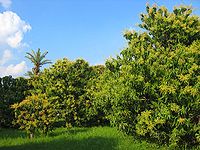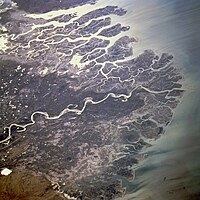
Back کشتوکاڵ لە پاکستان CKB Agriculture au Pakistan French სოფლის მეურნეობა პაკისტანში Georgian Сельское хозяйство Пакистана Russian پاڪستان ۾ زراعت Sindhi Agriculture in Pakistan SIMPLE Сільське господарство Пакистану Ukrainian




Agriculture is considered the backbone of Pakistan's economy, which relies heavily on its major crops.[1] Pakistan's principal natural resources are arable land and water. Agriculture accounts for about 18.9% [2] of Pakistan's GDP and employs about 42.3% of the labour force. The most agricultural province is Punjab where wheat & cotton are the most grown. Mango orchards are mostly found in Sindh and Punjab provinces, making it the world's fourth largest producer of mangoes.[3][4]
People rely on diesel to fuel their tractors, and consequently, an increase in diesel prices will further exacerbate their hardships.
Pakistan is a net importer of petroleum products, and any depreciation in the value of the rupee against the dollar has also led to higher prices for both petrol and diesel, which are extensively used by the general population.[5]
- ^ Rehman, Abdul; Jingdong, Luan; Shahzad, Babar; Chandio, Abbas Ali; Hussain, Imran; Nabi, Ghulam; Iqbal, Muhammad Shahid (2015-11-01). "Economic perspectives of major field crops of Pakistan: An empirical study". Pacific Science Review B: Humanities and Social Sciences. 1 (3): 145–158. doi:10.1016/j.psrb.2016.09.002. ISSN 2405-8831.
- ^ "Agriculture - Ministry of Finance" (PDF).
- ^ "Data" (PDF). www.pide.org.pk. 1996. Retrieved 2020-07-12.
- ^ "Report on mangoes" (PDF). www.tdap.gov.pk. Archived from the original (PDF) on 2019-07-10. Retrieved 2020-07-12.
- ^ "POL price hike adds to people's misery". The Express Tribune. 2023-09-01. Retrieved 2023-10-30.